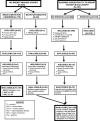Relationships between computer-extracted mammographic texture pattern features and BRCA1/2 mutation status: a cross-sectional study
- PMID: 25159706
- PMCID: PMC4268674
- DOI: 10.1186/s13058-014-0424-8
Relationships between computer-extracted mammographic texture pattern features and BRCA1/2 mutation status: a cross-sectional study
Abstract
Introduction: Mammographic density is similar among women at risk of either sporadic or BRCA1/2-related breast cancer. It has been suggested that digitized mammographic images contain computer-extractable information within the parenchymal pattern, which may contribute to distinguishing between BRCA1/2 mutation carriers and non-carriers.
Methods: We compared mammographic texture pattern features in digitized mammograms from women with deleterious BRCA1/2 mutations (n = 137) versus non-carriers (n = 100). Subjects were stratified into training (107 carriers, 70 non-carriers) and testing (30 carriers, 30 non-carriers) datasets. Masked to mutation status, texture features were extracted from a retro-areolar region-of-interest in each subject's digitized mammogram. Stepwise linear regression analysis of the training dataset identified variables to be included in a radiographic texture analysis (RTA) classifier model aimed at distinguishing BRCA1/2 carriers from non-carriers. The selected features were combined using a Bayesian Artificial Neural Network (BANN) algorithm, which produced a probability score rating the likelihood of each subject's belonging to the mutation-positive group. These probability scores were evaluated in the independent testing dataset to determine whether their distribution differed between BRCA1/2 mutation carriers and non-carriers. A receiver operating characteristic analysis was performed to estimate the model's discriminatory capacity.
Results: In the testing dataset, a one standard deviation (SD) increase in the probability score from the BANN-trained classifier was associated with a two-fold increase in the odds of predicting BRCA1/2 mutation status: unadjusted odds ratio (OR) = 2.00, 95% confidence interval (CI): 1.59, 2.51, P = 0.02; age-adjusted OR = 1.93, 95% CI: 1.53, 2.42, P = 0.03. Additional adjustment for percent mammographic density did little to change the OR. The area under the curve for the BANN-trained classifier to distinguish between BRCA1/2 mutation carriers and non-carriers was 0.68 for features alone and 0.72 for the features plus percent mammographic density.
Conclusions: Our findings suggest that, unlike percent mammographic density, computer-extracted mammographic texture pattern features are associated with carrying BRCA1/2 mutations. Although still at an early stage, our novel RTA classifier has potential for improving mammographic image interpretation by permitting real-time risk stratification among women undergoing screening mammography.
Figures



References
-
- Boyd NF, Lockwood GA, Byng JW, Tritchler DL, Yaffe MJ. Mammographic densities and breast cancer risk. Cancer Epidemiol Biomarkers Prev. 1998;7:1133–1144. - PubMed
Publication types
MeSH terms
Grants and funding
LinkOut - more resources
Full Text Sources
Other Literature Sources
Medical
Miscellaneous

